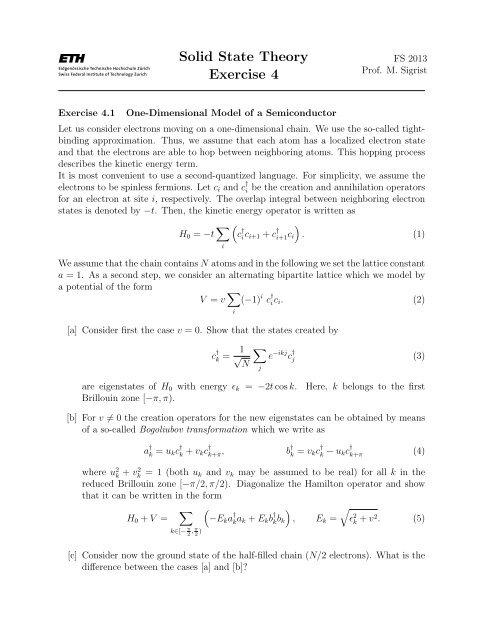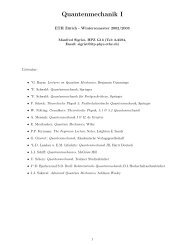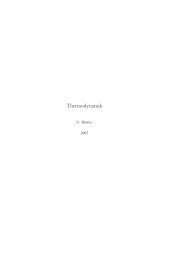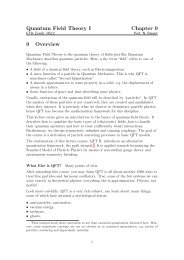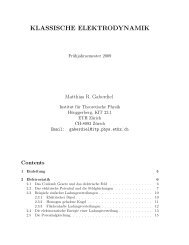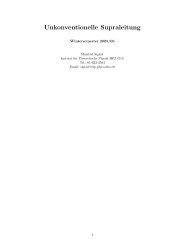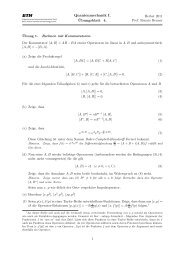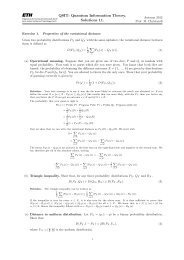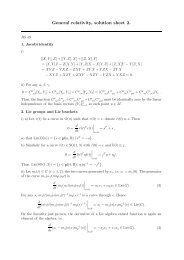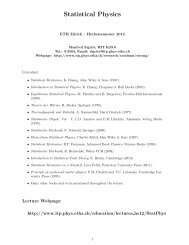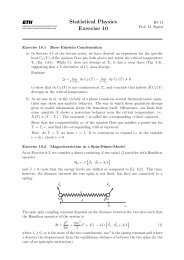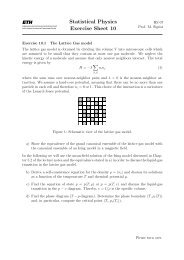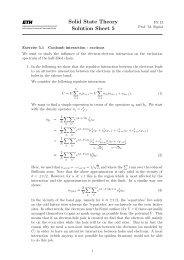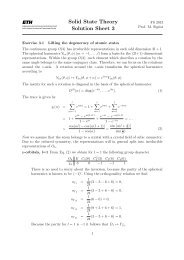Solid State Theory Exercise 4
Solid State Theory Exercise 4
Solid State Theory Exercise 4
Create successful ePaper yourself
Turn your PDF publications into a flip-book with our unique Google optimized e-Paper software.
<strong>Solid</strong> <strong>State</strong> <strong>Theory</strong><br />
<strong>Exercise</strong> 4<br />
FS 2013<br />
Prof. M. Sigrist<br />
<strong>Exercise</strong> 4.1<br />
One-Dimensional Model of a Semiconductor<br />
Let us consider electrons moving on a one-dimensional chain. We use the so-called tightbinding<br />
approximation. Thus, we assume that each atom has a localized electron state<br />
and that the electrons are able to hop between neighboring atoms. This hopping process<br />
describes the kinetic energy term.<br />
It is most convenient to use a second-quantized language. For simplicity, we assume the<br />
electrons to be spinless fermions. Let c i and c † i be the creation and annihilation operators<br />
for an electron at site i, respectively. The overlap integral between neighboring electron<br />
states is denoted by −t. Then, the kinetic energy operator is written as<br />
H 0 = −t ∑ (<br />
)<br />
c † i c i+1 + c † i+1 c i . (1)<br />
i<br />
We assume that the chain contains N atoms and in the following we set the lattice constant<br />
a = 1. As a second step, we consider an alternating bipartite lattice which we model by<br />
a potential of the form<br />
V = v ∑ (−1) i c † i c i. (2)<br />
i<br />
[a] Consider first the case v = 0. Show that the states created by<br />
c † k = √ 1 ∑<br />
e −ikj c † j (3)<br />
N<br />
are eigenstates of H 0 with energy ɛ k = −2t cos k. Here, k belongs to the first<br />
Brillouin zone [−π, π).<br />
[b] For v ≠ 0 the creation operators for the new eigenstates can be obtained by means<br />
of a so-called Bogoliubov transformation which we write as<br />
j<br />
a † k = u kc † k + v kc † k+π , b† k = v kc † k − u kc † k+π<br />
(4)<br />
where u 2 k + v2 k = 1 (both u k and v k may be assumed to be real) for all k in the<br />
reduced Brillouin zone [−π/2, π/2). Diagonalize the Hamilton operator and show<br />
that it can be written in the form<br />
H 0 + V =<br />
∑ (<br />
−E k a † k a k + E k b † k b k<br />
k∈[− π 2 , π 2 )<br />
)<br />
√<br />
, E k = ɛ 2 k + v2 . (5)<br />
[c] Consider now the ground state of the half-filled chain (N/2 electrons). What is the<br />
difference between the cases [a] and [b]?
<strong>Exercise</strong> 4.2<br />
Bloch Oscillations<br />
In the quasi-classical description of a wave-packet peaked around some quasi-momentum<br />
k the group velocity is given by<br />
ṙ = 1 ∂ε k<br />
∂k , (6)<br />
while the change of the quasi-momentum is given by<br />
˙k = F ext , (7)<br />
with F ext the force due to applied external fields (in addition to the periodic potential).<br />
[a] We focus on the one-dimensional tight-binding model from [a] above with dispersion<br />
relation<br />
ε k = −2t cos(ka). (8)<br />
Show that a uniform electric field does not accelerate the electrons but lets them<br />
oscillate around some fixed position. This means that, for sufficiently large fields, all<br />
metals would behave like insulators. Why has this effect never been seen in normal<br />
metals? What would change if we considered semiconductor superlattices instead<br />
of metals?<br />
[b] We now add a small damping term to Eq. (7) and analyze the consequences. The<br />
rate of change of the quasi-momentum is thus given by<br />
˙k = F ext − mṙ<br />
τ , (9)<br />
where τ is the relaxation time. Show that this damping can lead to a vanishing of the<br />
oscillations and thus to a stationary solution. What is the corresponding condition<br />
and how does the stationary solution look like? Calculate then analytically k(t) for<br />
both situations to verify your considerations.<br />
Contact person:<br />
Juan Osorio (HIT G 32.4)<br />
osorio@itp.phys.ethz.ch


